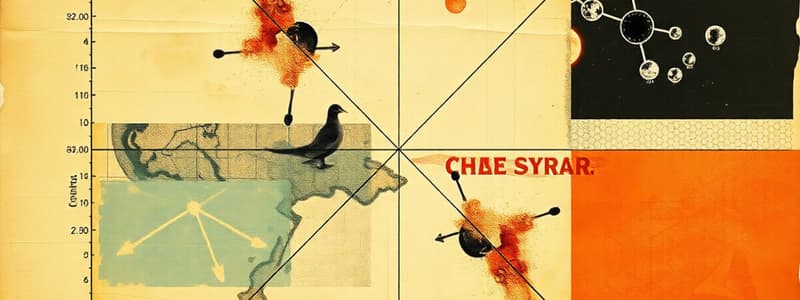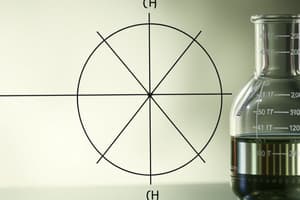Podcast
Questions and Answers
Which of the following represents a strong electrolyte?
Which of the following represents a strong electrolyte?
A supersaturated solution contains the maximum amount of a solute that can dissolve at a given temperature.
A supersaturated solution contains the maximum amount of a solute that can dissolve at a given temperature.
False (B)
What is the formula for calculating boiling point elevation?
What is the formula for calculating boiling point elevation?
ΔTB = iKBm
______ is the phenomenon where a gas becomes less soluble in a liquid at higher temperatures.
______ is the phenomenon where a gas becomes less soluble in a liquid at higher temperatures.
Signup and view all the answers
Match the following terms with their definitions:
Match the following terms with their definitions:
Signup and view all the answers
Which statement correctly describes colligative properties?
Which statement correctly describes colligative properties?
Signup and view all the answers
What does the van’t Hoff factor (i) represent?
What does the van’t Hoff factor (i) represent?
Signup and view all the answers
Henry's Law states that the solubility of a gas is directly proportional to its pressure.
Henry's Law states that the solubility of a gas is directly proportional to its pressure.
Signup and view all the answers
What does a catalyst do during a chemical reaction?
What does a catalyst do during a chemical reaction?
Signup and view all the answers
The overall reaction order can only be determined theoretically.
The overall reaction order can only be determined theoretically.
Signup and view all the answers
What is the role of the activation energy (Ea) in a chemical reaction?
What is the role of the activation energy (Ea) in a chemical reaction?
Signup and view all the answers
According to collision theory, reactions must have a proper _________ of reactant molecules to occur.
According to collision theory, reactions must have a proper _________ of reactant molecules to occur.
Signup and view all the answers
Match the following terms with their definitions:
Match the following terms with their definitions:
Signup and view all the answers
What does the Arrhenius equation describe?
What does the Arrhenius equation describe?
Signup and view all the answers
In an exothermic reaction, the enthalpy change (ΔH) is greater than zero.
In an exothermic reaction, the enthalpy change (ΔH) is greater than zero.
Signup and view all the answers
What is the definition of dynamic equilibrium?
What is the definition of dynamic equilibrium?
Signup and view all the answers
According to Hess’s Law, the overall enthalpy change (ΔHº) for a reaction is __________ of the steps taken to achieve it.
According to Hess’s Law, the overall enthalpy change (ΔHº) for a reaction is __________ of the steps taken to achieve it.
Signup and view all the answers
Match the following types of reactions with their characteristics:
Match the following types of reactions with their characteristics:
Signup and view all the answers
What does a large equilibrium constant (K >> 1) indicate?
What does a large equilibrium constant (K >> 1) indicate?
Signup and view all the answers
The standard enthalpy of formation (ΔHfº) of an element in its standard state is defined as zero.
The standard enthalpy of formation (ΔHfº) of an element in its standard state is defined as zero.
Signup and view all the answers
What is the equation used to calculate the change in entropy (ΔS) of a reaction?
What is the equation used to calculate the change in entropy (ΔS) of a reaction?
Signup and view all the answers
For the reaction 3NO(g) → N2O(g) + NO2(g), if ΔHº = -100 kJ, this means the reaction is __________.
For the reaction 3NO(g) → N2O(g) + NO2(g), if ΔHº = -100 kJ, this means the reaction is __________.
Signup and view all the answers
What is the value of the average kinetic energy per mole of gas at temperature T?
What is the value of the average kinetic energy per mole of gas at temperature T?
Signup and view all the answers
Boyle’s Law states that pressure is directly proportional to volume.
Boyle’s Law states that pressure is directly proportional to volume.
Signup and view all the answers
What is the molar volume of a gas at standard temperature and pressure (STP)?
What is the molar volume of a gas at standard temperature and pressure (STP)?
Signup and view all the answers
The equation for the Ideal Gas Law is PV = _____.
The equation for the Ideal Gas Law is PV = _____.
Signup and view all the answers
Match the gas laws with their relationships:
Match the gas laws with their relationships:
Signup and view all the answers
Which law relates the rates of effusion of two gases to their molar masses?
Which law relates the rates of effusion of two gases to their molar masses?
Signup and view all the answers
London Dispersion Forces are present in all molecules.
London Dispersion Forces are present in all molecules.
Signup and view all the answers
In the Van der Waals equation, what does the 'a' parameter account for?
In the Van der Waals equation, what does the 'a' parameter account for?
Signup and view all the answers
The total pressure for a gas mixture is equal to the sum of the partial pressures of its components, expressed as P_Tot = P_A + _____.
The total pressure for a gas mixture is equal to the sum of the partial pressures of its components, expressed as P_Tot = P_A + _____.
Signup and view all the answers
What type of intermolecular force is required for hydrogen bonding?
What type of intermolecular force is required for hydrogen bonding?
Signup and view all the answers
What type of bond is formed by the first bond in a double or triple bond?
What type of bond is formed by the first bond in a double or triple bond?
Signup and view all the answers
Metal oxides are acidic.
Metal oxides are acidic.
Signup and view all the answers
What is the primary type of bond formed in a triple bond?
What is the primary type of bond formed in a triple bond?
Signup and view all the answers
The effective nuclear charge (Zeff) is calculated by the formula Zeff = Z - ___.
The effective nuclear charge (Zeff) is calculated by the formula Zeff = Z - ___.
Signup and view all the answers
Match the following groups with their properties:
Match the following groups with their properties:
Signup and view all the answers
What happens to reactivity of alkaline earth metals as you move down the group?
What happens to reactivity of alkaline earth metals as you move down the group?
Signup and view all the answers
Electronegativity increases as you move down a group in the periodic table.
Electronegativity increases as you move down a group in the periodic table.
Signup and view all the answers
Define ionization energy.
Define ionization energy.
Signup and view all the answers
The formula for pressure is given by P = ___ / A.
The formula for pressure is given by P = ___ / A.
Signup and view all the answers
Which of the following ions is the largest in size?
Which of the following ions is the largest in size?
Signup and view all the answers
Study Notes
Solutions and Concentration
- Solvent and Solute: Solvent dissolves the solute; solute is the substance being dissolved.
- Saturated Solution: Contains the maximum amount of solute that can dissolve.
- Unsaturated Solution: Contains less than the maximum amount of solute that can dissolve.
- Supersaturated Solution: Contains more solute than can typically dissolve at that temperature.
- Strong Electrolytes: Fully dissociate into ions in water; include strong acids, strong bases, and soluble ionic compounds.
- Weak Electrolytes: Partially dissociate into ions in water; include weak acids and weak bases.
- Nonelectrolytes: Do not dissociate into ions in water.
Concentration Calculations
- Molarity (M): moles of solute per liter of solution.
- Molality (m): moles of solute per kilogram of solvent.
Solubility of Compounds
- Ionic Compounds: Group I metals, NH4+, NO3-, ClO4-, and C2H3O2- salts are soluble.
- Insoluble Salts: Ag+, Pb2+, Hg22+, and S2- salts are generally insoluble.
- Solubility Trends: Solids are more soluble at higher temperatures; gases are less soluble at higher temperatures and more soluble at higher pressures.
Colligative Properties
- Van’t Hoff Factor (i): Number of particles a compound dissociates into per formula unit.
- Freezing Point Depression: ΔTF = -iKF m.
- Boiling Point Elevation: ΔTB = iKB m.
- Vapor Pressure Depression (Raoult’s Law): PA = χA PA*.
- Osmotic Pressure: π = iMRT.
Chemical Kinetics
- Arrhenius Equation: k = Ae^(-Ea/RT), relating rate constant (k) to temperature and activation energy (Ea).
- Reaction Mechanisms: Involves elementary reactions which can be unimolecular, bimolecular, or termolecular.
Chemical Equilibrium
- Dynamic Equilibrium: Forward rate equals reverse rate.
- Equilibrium Constant (K): Kc = [products]/[reactants], indicating the extent of the reaction.
- Spontaneity: K >> 1 denotes products favored at equilibrium.
Thermodynamics and Enthalpy
- Endothermic vs. Exothermic: Endothermic reactions have ΔH > 0; exothermic have ΔH < 0.
- Hess's Law: Used to calculate reaction enthalpies through known reaction steps.
- Enthalpies of Formation: ΔHo = ΣnΔHof,products - ΣnΔHof,reactants.
Gas Laws
- Ideal Gas Law: PV = nRT relates pressure (P), volume (V), number of moles (n), ideal gas constant (R), and temperature (T).
- Boyle’s Law: P inversely proportional to V at constant T.
- Charles’s Law: V directly proportional to T at constant P.
- Dalton’s Law of Partial Pressures: Total pressure equals the sum of individual gas pressures.
Intermolecular Forces
- Types of Forces:
- Hydrogen Bonding: Strong interaction involving H bonded to F, O, or N.
- Ion-Dipole Forces: Attraction between ions and polar molecules.
- Dipole-Dipole Forces: Interactions between polar molecules.
- London Dispersion Forces: Weak interactions present in all molecules.
Periodic Properties
- Alkali Metals: Highly reactive; form ionic compounds.
- Alkaline Earth Metals: Reactive with water; reactivity increases down the group.
- Halogens: High electron affinity, very reactive nonmetals.
- Noble Gases: Chemically inert; have a full valence shell.
Kinetic Molecular Theory
- Key Assumptions:
- Gas molecules have negligible volume.
- No intermolecular attractions; collisions are elastic.
- Average kinetic energy correlates with temperature.
Reaction Rates
- Rate Expressions: Define the change in concentration over time.
- Rate Laws: Determine the relationship between concentration and reaction rate.
- Catalysts: Increase reaction rates without being consumed, by lowering activation energy.
Collision Theory
- Requirements for Reactions:
- Collisions must occur.
- Proper orientation of reactant molecules.
- Sufficient energy for a reaction to happen.
Studying That Suits You
Use AI to generate personalized quizzes and flashcards to suit your learning preferences.
Related Documents
Description
Explore the concepts of phase diagrams for carbon dioxide and water. This quiz covers terminology related to solutions, including solvent and solute, as well as saturated and unsaturated solutions. Test your understanding of these essential topics in chemistry.




